
No-till, winter cover crops
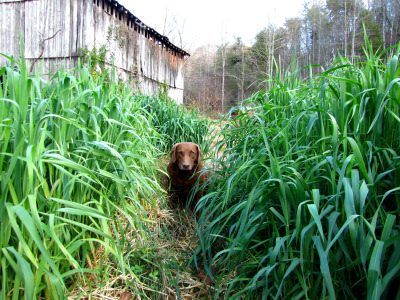 By
now, parts of your summer garden are probably toast. That early
sweet corn should be long gone, maybe you pulled out some buggy beans, and you're about to dig
your potatoes. Or perhaps you have trouble zones where the soil
wasn't good enough to support much of a crop and you're thinking about
writing that bed off entirely. Once you set aside some good
ground for your fall
garden, now's the
perfect time to plant the rest in winter cover crops --- they'll create
organic matter, prevent erosion, cut down on winter weed growth, and
add beauty to the winter garden.
By
now, parts of your summer garden are probably toast. That early
sweet corn should be long gone, maybe you pulled out some buggy beans, and you're about to dig
your potatoes. Or perhaps you have trouble zones where the soil
wasn't good enough to support much of a crop and you're thinking about
writing that bed off entirely. Once you set aside some good
ground for your fall
garden, now's the
perfect time to plant the rest in winter cover crops --- they'll create
organic matter, prevent erosion, cut down on winter weed growth, and
add beauty to the winter garden.
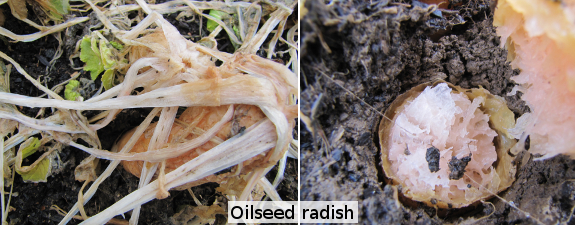
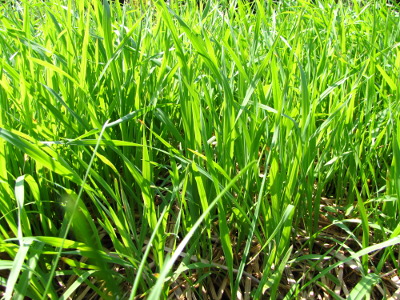 The
perfect winter cover crop for a no-till garden can handle problematic
soil conditions, will thrive in the fall and early winter, then
naturally dies back when the coldest part of winter hits. Here in
zone 6, I've found only two winners that really fit the bill --- oats and oilseed
radishes. Oats
have the advantage that they are available at my local feed store
(which means the seeds are dirt cheap) and the plants leave behind a
light mulch that will protect the soil until it's time to plant summer
vegetables. Oilseed radishes hold their own, though, by aerating
and adding organic matter deep in poor soil, then rotting fast enough
that I can plant spring vegetables directly behind them. After a
year of experimentation, I've decided that oilseed radishes will go
into the very poorest soil of my garden while oats will be planted
almost everywhere else.
The
perfect winter cover crop for a no-till garden can handle problematic
soil conditions, will thrive in the fall and early winter, then
naturally dies back when the coldest part of winter hits. Here in
zone 6, I've found only two winners that really fit the bill --- oats and oilseed
radishes. Oats
have the advantage that they are available at my local feed store
(which means the seeds are dirt cheap) and the plants leave behind a
light mulch that will protect the soil until it's time to plant summer
vegetables. Oilseed radishes hold their own, though, by aerating
and adding organic matter deep in poor soil, then rotting fast enough
that I can plant spring vegetables directly behind them. After a
year of experimentation, I've decided that oilseed radishes will go
into the very poorest soil of my garden while oats will be planted
almost everywhere else.
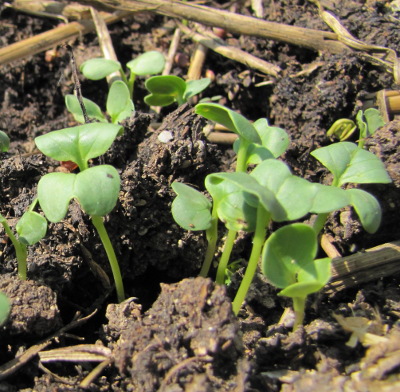 So, when do you plant winter
cover crops? Again, this will be climate specific, but I plant
oats betwen August 1 and September 15 and oilseed radishes between
August 1 and September 7. If you plant too late, your cover crops
won't do much good and you'll instead enter the next garden year with
lots of weeds. On the other hand, plant too early and your cover
crops might go to seed and produce weed problems of their own (although
you can stave this off with oats by mowing the mature plants.)
So, when do you plant winter
cover crops? Again, this will be climate specific, but I plant
oats betwen August 1 and September 15 and oilseed radishes between
August 1 and September 7. If you plant too late, your cover crops
won't do much good and you'll instead enter the next garden year with
lots of weeds. On the other hand, plant too early and your cover
crops might go to seed and produce weed problems of their own (although
you can stave this off with oats by mowing the mature plants.)
Unless you have fancy
equipment to do the work for you, cover crops aren't worth the extra
effort of seeding in rows. Instead, I've had good luck
broadcasting oat seeds on the soil surface and covering them with a
very light mulch of straw to keep the ground moist 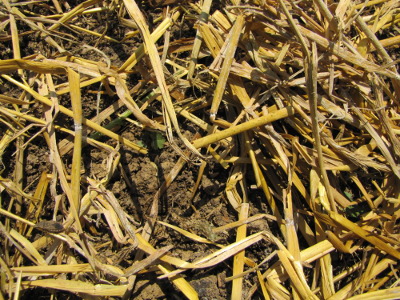 while preventing seed
predation by our
intelligent sparrows and cardinals. Radish seeds are less tasty,
so I often toss them directly onto the soil surface with no further
care. (Do be aware that in really hot, dry weather, the radish
seedlings can burn to a crisp if planted this way.) A safer (but
more time-consuming method) for planting both is to rake
back the top half inch of soil, broadcast your seeds, and pull the soil
back overtop.
while preventing seed
predation by our
intelligent sparrows and cardinals. Radish seeds are less tasty,
so I often toss them directly onto the soil surface with no further
care. (Do be aware that in really hot, dry weather, the radish
seedlings can burn to a crisp if planted this way.) A safer (but
more time-consuming method) for planting both is to rake
back the top half inch of soil, broadcast your seeds, and pull the soil
back overtop.
There are several winter
cover crops that can be planted later than September 15, but I've found
that barley, crimson clover, and (especially) annual ryegrass are tough
to kill
without tilling.
I suspect that any cover crop that can be planted within a month of the
first frost date will be too cold hardy to die on its own over the
winter. For beginners who live in zone 6 or colder, I'd recommend
sticking to oats and oilseed radishes this year for a beautiful and
bountiful winter cover crop.
Want more in-depth information? Browse through our books.
Or explore more posts by date or by subject.
About us: Anna Hess and Mark Hamilton spent over a decade living self-sufficiently in the mountains of Virginia before moving north to start over from scratch in the foothills of Ohio. They've experimented with permaculture, no-till gardening, trailersteading, home-based microbusinesses and much more, writing about their adventures in both blogs and books.
Want to be notified when new comments are posted on this page? Click on the RSS button after you add a comment to subscribe to the comment feed, or simply check the box beside "email replies to me" while writing your comment.

Anna
Where have you found to be the best place to purchase radish seed to be used as a cover crop from?
Thanks
Kevin
Oilseed radishes are pretty popular right now, so it can be tough to find a source at this time of year. There are also a lot of named varieties that are especially suitable for drilling through hardpan --- look for tillage radishes or groundhog radishes if you need that kind of help (and expect them to be sold out.)
But if you just want oilseed radishes for aerating heavy clay or something similar and can't find them at your local feed store, you can go to my source --- Johnny's Selected Seeds. Expect to pay a whopping $7.55 per pound (which drops to about $3 per pound if you buy a 50 pound bag), drastically more than the quarter a pound I paid for my oat seeds. That's why the oats are my primary winter cover crop!
Anna, Can you sow a few and save seeds for next ear? That is a pretty expensive cover crop for sure. What are your thoughts on buckwheat? I threw some out in am empty bed mainly be ause I didnt have anything else, but it is supposed to have some good cover crop qualities...
Deb --- I'd need to sow the oilseed radishes in the spring for seed saving since they winter-kill. But I want to give it a try --- the seeds are expensive.
We like buckwheat in the summer a lot. It fits into month-long gaps perfectly, and really does produce a lot of biomass (as long as your soil is already moderately okay --- it doesn't thrive in poor soil amid weeds.)